Differentiated Optimization of Sustainable Land Use in Metropolitan Areas: A Demarcation of Functional Units for Land Consolidation
Abstract
:1. Introduction
2. Methodology for Demarcation of FULC
2.1. Definition of FULC
2.2. Demarcation Steps of FULC
2.2.1. Determination of Functional Areas for Land Consolidation
2.2.2. Determination of Evaluation Unit
2.2.3. Index System Construction of Production-Life-Ecology Function Evaluation
2.2.4. Functional Capacity Evaluation of Land Consolidation
Determination of Land Function Endowment
Determination of Physical Space Function Target Value
Determination of Social Space Target Value
2.2.5. Determination of FULC
3. A Case Study on Haidian, Beijing
3.1. General Situation of the Study Area
3.2. Data Source
3.3. Demarcation Result of FULC
3.3.1. Orientation Result of Functional Areas for Land Consolidation
3.3.2. Determination of Evaluation Unit
3.3.3. Construction of Production-life-ecology Index System Function Evaluation
3.3.4. Functional Capacity Measurement of Land Consolidation
3.3.5. Functional Unit Determination for Land Consolidation
4. Discussions
4.1. Mixture of the Bottom–Up and Top–Down Approaches
4.2. The Categories of FULCs and Implementation Mechanisms
4.3. The Explanations of More Disparities Found in the Rural Areas
4.4. The Reason of Case Selection and the Limitations of the Framework
5. Conclusions
Acknowledgments
Author Contributions
Conflicts of Interest
References
- Pannell, C.W. China’s continuing urban transition. Environ. Plan. A 2002, 34, 1571–1590. [Google Scholar] [CrossRef]
- Wang, L.; Li, C.; Ying, Q.; Cheng, X.; Wang, X.; Li, X.; Hu, L.L.; Yu, L.; Huang, L.; Gong, H.P. China’s urban expansion from 1990 to 2010 determined with satellite remote sensing. Chin. Sci. Bull. 2012, 57, 2802–2812. [Google Scholar] [CrossRef]
- Chen, M.; Liu, W.; Tao, X. Evolution and assessment on China’s urbanization 1960–2010: Under-urbanization or over-urbanization? Habitat Int. 2013, 38, 25–33. [Google Scholar] [CrossRef]
- Yan, J.; Xia, F.; Bao, H.X.H. Strategic planning framework for land consolidation in China: Atop-level design based on SWOT analysis. Habitat Int. 2015, 48, 46–54. [Google Scholar] [CrossRef] [Green Version]
- Nguyen, T.; Cheng, E.; Findlay, C. Land fragmentation and farm productivity in China in the 1990. China Econ. Rev. 1996, 7, 169–180. [Google Scholar] [CrossRef]
- Zhang, Z.; Zhao, W.; Gu, X. Changes resulting from a land consolidation project (LCP) and its resource-environment effects: A case study in Tianmen City of Hubei Province, China. Land Use Policy 2014, 40, 74–82. [Google Scholar] [CrossRef]
- Li, Y.; Liu, Y.; Long, H.L.; Cui, W. Community-based rural residential land consolidation and allocation can help to revitalize hollowed villages in traditional agricultural areas of China: Evidence from Dancheng County, Henan Province. Land Use Policy 2014, 39, 188–219. [Google Scholar] [CrossRef]
- Liu, Y.S.; Liu, Y. Progress and prospect on the study of rural hollowing in China. Geogr. Res. 2010, 29, 35–42. (In Chinese) [Google Scholar]
- Wang, J.Y.; Liu, Y.S.; Chen, Y.F. Spatial expansion pattern and its dynamic mechanism of typical rural settlements in Huang-Huai-Hai Plain. Geogr. Res. 2010, 29, 1833–1840. (In Chinese) [Google Scholar]
- Lu, S. Spatio-Temporal Patterns and Policy Implications of Urban Land Expansion in Metropolitan Areas: A Case Study of Wuhan Urban Agglomeration, Central China. Sustainability 2014, 6, 4723–4748. [Google Scholar] [CrossRef]
- Zhang, Z.; Tang, W.; Gong, J.; Huan, J. Property rights of urban underground space in China: A public good perspective. Land Use Policy 2017, 65, 224–237. [Google Scholar] [CrossRef]
- Xia, F.Z.; Shen, Y.; Yan, J.M.; Bao, H.X.H. On the Potential of Urban Three-dimensional Space Development: The Case of Liuzhou, China. Habitat Int. 2016, 51, 48–58. [Google Scholar] [CrossRef]
- Miranda, D.; Crecente, R.; Alvarez, M.F. Land consolidation in inland rural Galicia, N.W. Spain, since 1950: An example of the formulation and use of questions, criteria and indicators for evaluation of rural development policies. Land Use Policy 2006, 23, 511–520. [Google Scholar] [CrossRef]
- Yan, J.; Xia, F.; Li, Q. Top strategy design of comprehensive land consolidation in China. Trans. Chin. Soc. Agric. Eng. 2012, 28, 1–9. (In Chinese) [Google Scholar]
- Sklenicka, P. Applying evaluation criteria for the land consolidation effect to three contrasting study areas in Czech Republic. Land Use Policy 2006, 23, 502–510. [Google Scholar] [CrossRef]
- Van, D.T. Complications for traditional land consolidation in Central Europe. Geoforum 2007, 38, 505–511. [Google Scholar]
- Lier, H.N.V. Land use planning and land consolidation in the future in Europe. Z. Fur Kult. Landentwickl. 2000, 41, 138–143. [Google Scholar]
- Gonzalez, X.P.; Alvarez, C.J.; Crecente, R. Evaluation of land distributions with joint regard to plot size and shape. Agric. Syst. 2004, 82, 31–43. [Google Scholar] [CrossRef]
- Crecente, R.; Alvarez, C.; Frau, U. Economic, social and environmental impact of land consolidation in Galicia. Land Use Policy 2002, 19, 135–147. [Google Scholar] [CrossRef]
- Wittlingerova, Z.; Kriz, L. The effect of anthropogenic activities on the chemical properties of ground waters. Rostl. Vyroba 1998, 44, 321–324. [Google Scholar]
- Zhou, J.; Qin, X.; Liu, L.; Hu, Y. A potential evaluation model for land consolidation in fragmental regions. Ecol. Indic. 2017, 74, 230–240. [Google Scholar] [CrossRef]
- Thapa, G.; Niroula, G. Alternative options of land consolidation in the mountains of Nepal: An analysis based on stakeholders’ opinions. Land Use Policy 2008, 25, 338–350. [Google Scholar] [CrossRef]
- Pasakarnis, G.; Maliene, V. Towards sustainable rural development in Central and Eastern Europe: Applying land consolidation. Land Use Policy 2010, 27, 545–549. [Google Scholar] [CrossRef]
- Brink, D.V. Land consolidation and the emergence of the metropolitan landscape. In Proceedings of the Symposium on Modern Land Consolidation, Volvic, France, 10–11 September 2004. [Google Scholar]
- Haldrup, N.O. Agreement based land consolidation-In perspective of new modes of governance. Land Use Policy 2015, 46, 163–177. [Google Scholar] [CrossRef]
- Lu, Y. Integrating Future Land Use Scenarios to Evaluate the Spatio-Temporal Dynamics of Landscape Ecological Security. Sustainability 2016, 8, 1242. [Google Scholar] [CrossRef]
- Porta, J.; Parapar, J.; Doallo, R.; Barbosa, V.; Santé, I.; Crecente, R.; Díaz, C. A population-based iterated greedy algorithm for the delimitation and zoning of rural settlements. Comput. Environ. Urban Syst. 2013, 39, 12–26. [Google Scholar] [CrossRef]
- Lu, W.; Liu, J.; Xiang, X.Q.; Song, W.L.; Mcilgorm, A. A comparison of marine spatial planning approaches in China: Marine functional zoning and the marine ecological red line. Mar. Policy 2015, 62, 94–101. [Google Scholar] [CrossRef]
- Schäfer, M.; Kröger, M. Joint problem framing in sustainable land use research: Experience with Constellation Analysis as a method for inter- and trans-disciplinary knowledge integration. Land Use Policy 2016, 57, 526–539. [Google Scholar] [CrossRef]
- Nackoney, J.; Rybock, D.; Dupain, J.; Facheux, C. Coupling participatory mapping and GIS to inform village-level agricultural zoning in the Democratic Republic of the Congo. Landsc. Urban Plan. 2013, 110, 164–174. [Google Scholar] [CrossRef]
- Fei, D.; Cheng, Q.; Mao, X.; Liu, F.; Zhou, Q. Land use zoning using a coupled gridding-self-organizing feature maps method: A Case Study in China. J. Clean. Prod. 2017, in press. [Google Scholar] [CrossRef]
- Rosa, M.D.; Knudsen, M.T.; Hermansen, J.E. A comparison of Land Use Change models: Challenges and future developments. J. Clean. Prod. 2016, 113, 183–193. [Google Scholar] [CrossRef]
- Wrbka, T.; Erb, K.H.; Schulz, N.B.; Peterseil, J.; Hahn, C.; Haberl, H. Linking pattern and process in cultural landscape. An empirical study based on spatially explicit indicators. Land Use Policy 2004, 21, 289–306. [Google Scholar] [CrossRef]
- Godschalk, D. Land use planning challenges: Coping with conflicts in sustainable development and livability community visions. J. Am. Plan. Assoc. 2004, 70, 5–13. [Google Scholar] [CrossRef]
- Huub, S. Challenges for Crop Production Research in Improving Land Use, Productivity and Sustainability. Sustainability 2013, 5, 1632–1644. [Google Scholar]
- Leung, H. Land Use Planning Made Plain; Ronald P. Frye & Company: Toronto, ON, Canada, 1999. [Google Scholar]
- Xia, C.; Yan, J. Indicator System of Implementation Evaluation for Land Use Planning. China Land Sci. 2006, 02, 19–23, (In Chinese with English Abstract). [Google Scholar]
- Alonso, A.; Monzón, A.; Wang, Y. Modelling Land Use and Transport Policies to Measure Their Contribution to Urban Challenges: The Case of Madrid. Sustainability 2017, 9, 378. [Google Scholar] [CrossRef]
- Han, H.; Yang, C.; Song, J. Scenario Simulation and the Prediction of Land Use and Land Cover Change in Beijing, China. Sustainability 2015, 7, 4260–4279. [Google Scholar] [CrossRef]
- Karyn, M. Producing regional production multipliers for Irish marine sector policy: A location quotient approach. Ocean Coast. Manag. 2014, 91, 58–64. [Google Scholar]
- Stephen, B.B.; Erik, B.J. The location quotient as an estimator of industrial concentration. Reg. Sci. Urban Econ. 2012, 42, 642–647. [Google Scholar]
- Xu, K.; Kong, C.; Li, J.; Zhang, L.; Wu, C. Suitability evaluation of urban construction land based on geo-environmental factors of Hangzhou, China. Comput. Geosci. 2011, 37, 992–1002. [Google Scholar] [CrossRef]
- Tang, X.; Pan, Y.; Liu, Y. Analysis and demonstration of investment implementation model and paths for China’s cultivated land consolidation. Appl. Geogr. 2017, 82, 24–34. [Google Scholar] [CrossRef]
- Demetriou, D.; Stillwell, J.; See, L. Land consolidation in Cyprus: Why is an Integrated Planning and Decision Support System required? Land Use Policy 2012, 29, 131–142. [Google Scholar] [CrossRef]
- Long, H.L. Land consolidation: An indispensable way of spatial restructuring in rural China. J. Geogr. Sci. 2014, 24, 211–225. [Google Scholar] [CrossRef]
- Jin, X.; Xu, X.; Xiang, X.; Bai, Q.; Zhou, Y. System-dynamic analysis on socio-economic impacts of land consolidation in China. Habitat Int. 2016, 56, 166–175. [Google Scholar] [CrossRef]
- Jiang, L.; Deng, X.; Seto, K.C. The impact of urban expansion on agricultural land use intensity in China. Land Use Policy 2013, 35, 33–39. [Google Scholar] [CrossRef]
- Zhang, X.; Du, S. A Linear Dirichlet Mixture Model for decomposing scenes: Application to analyzing urban functional zonings. Remote Sens. Environ. 2015, 169, 37–49. [Google Scholar] [CrossRef]
- Hughen, W.K.; Read, D.C. Read Analyzing form-based zoning’s potential to stimulate mixed-use development in different economic environments. Land Use Policy 2017, 61, 1–11. [Google Scholar] [CrossRef]
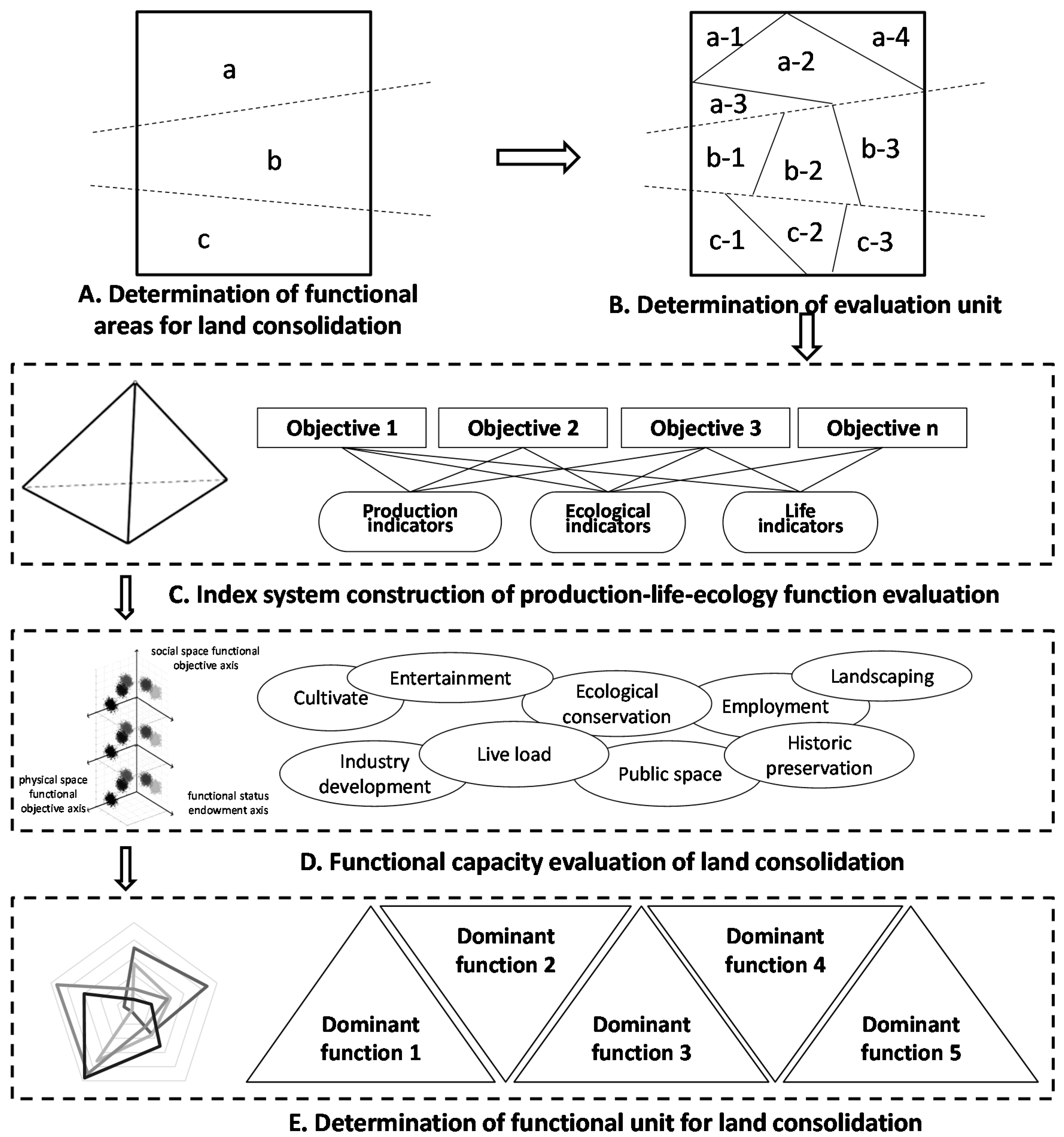
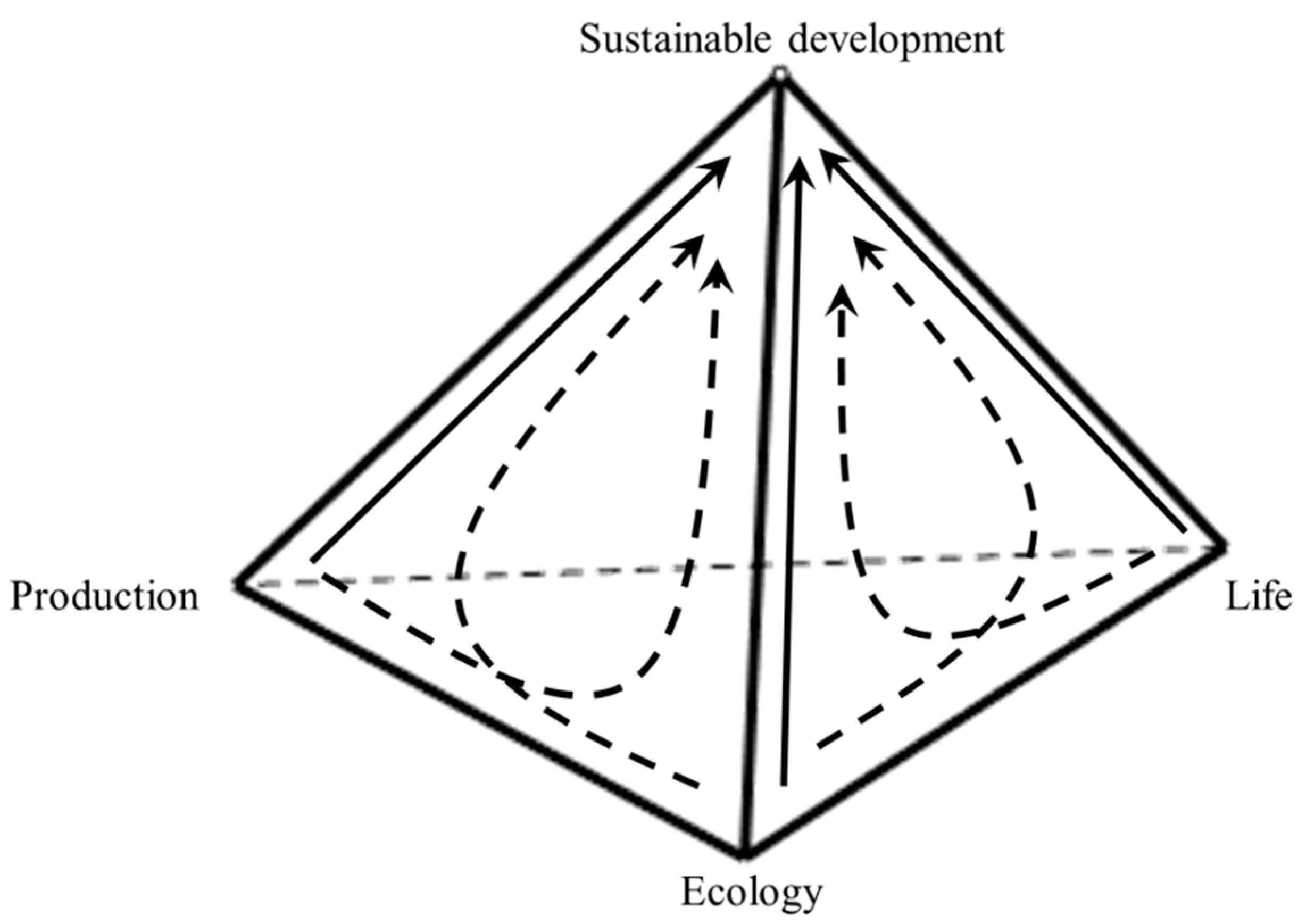
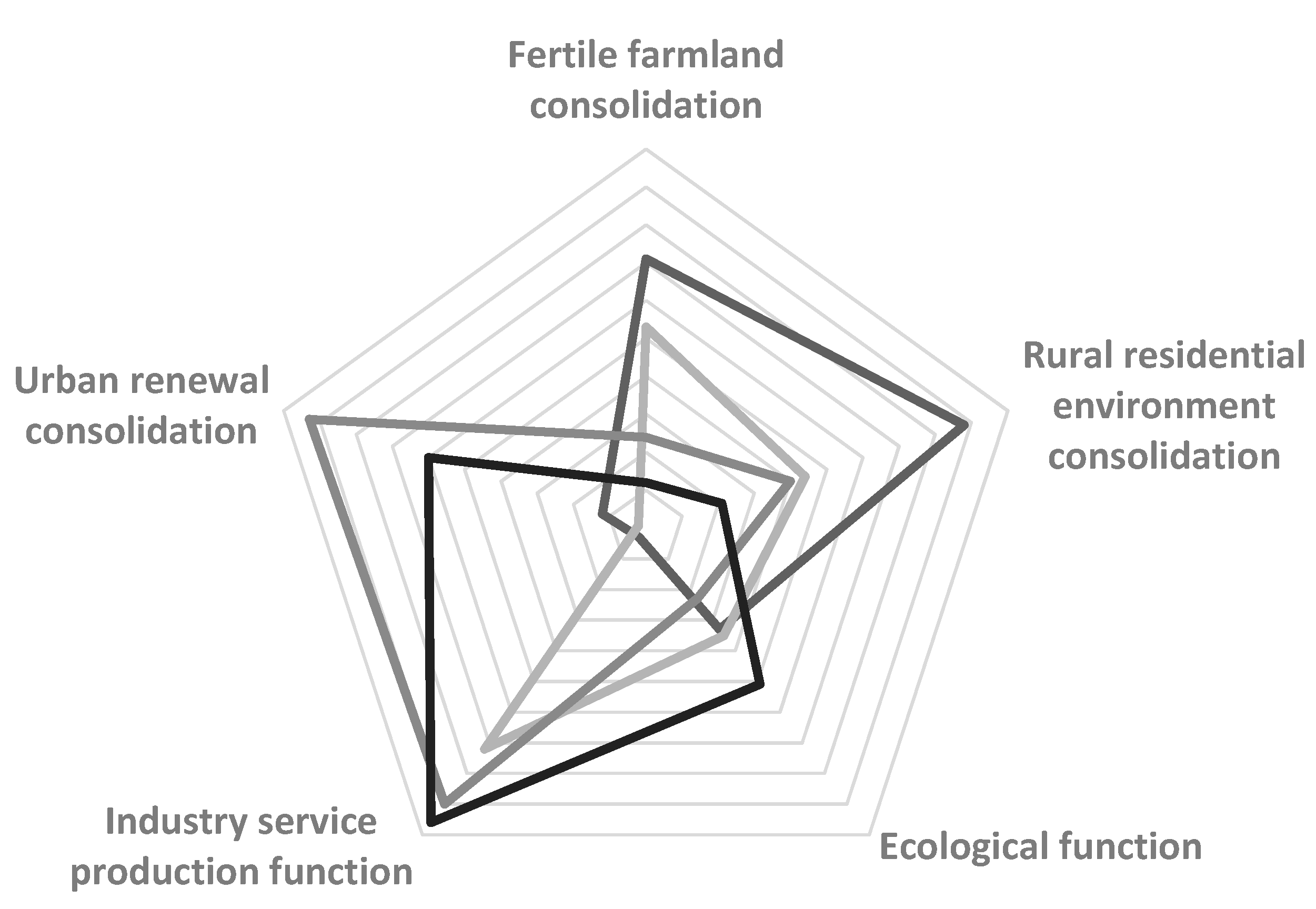

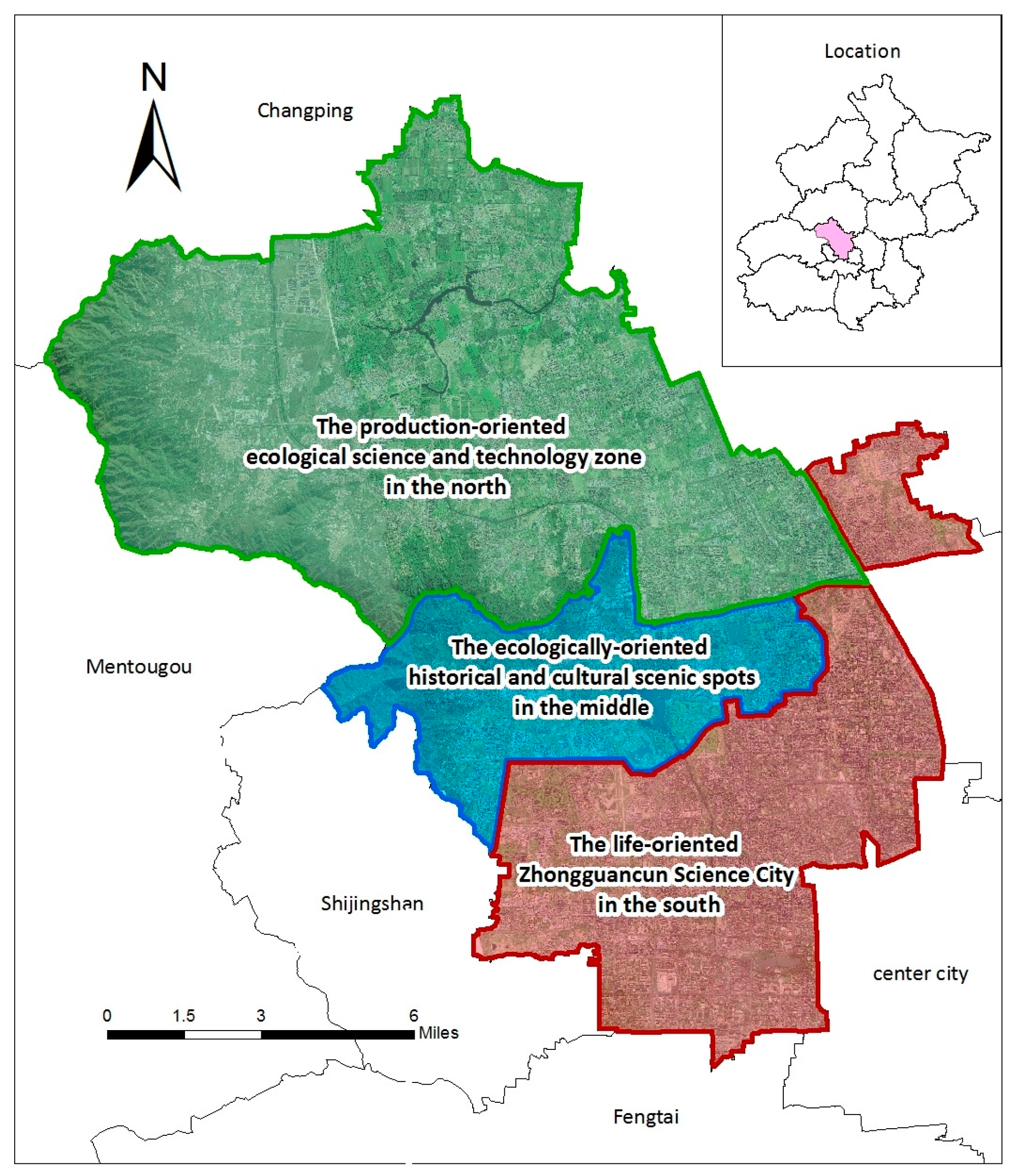

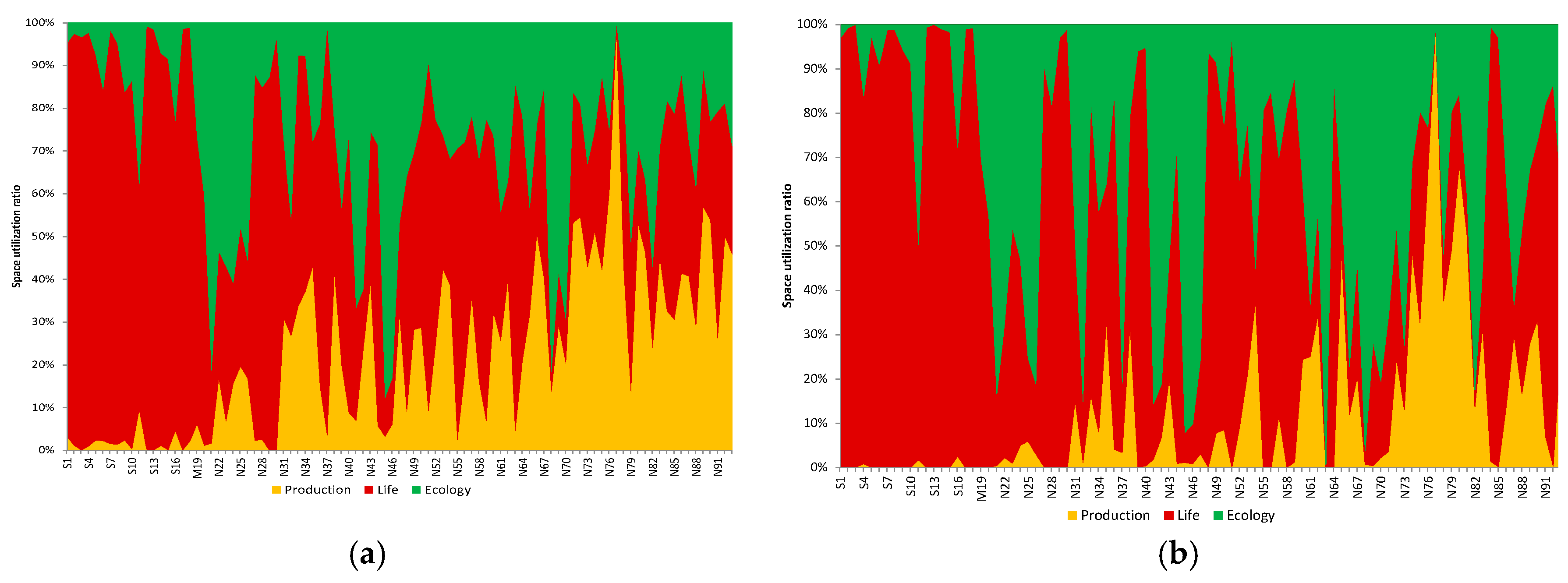
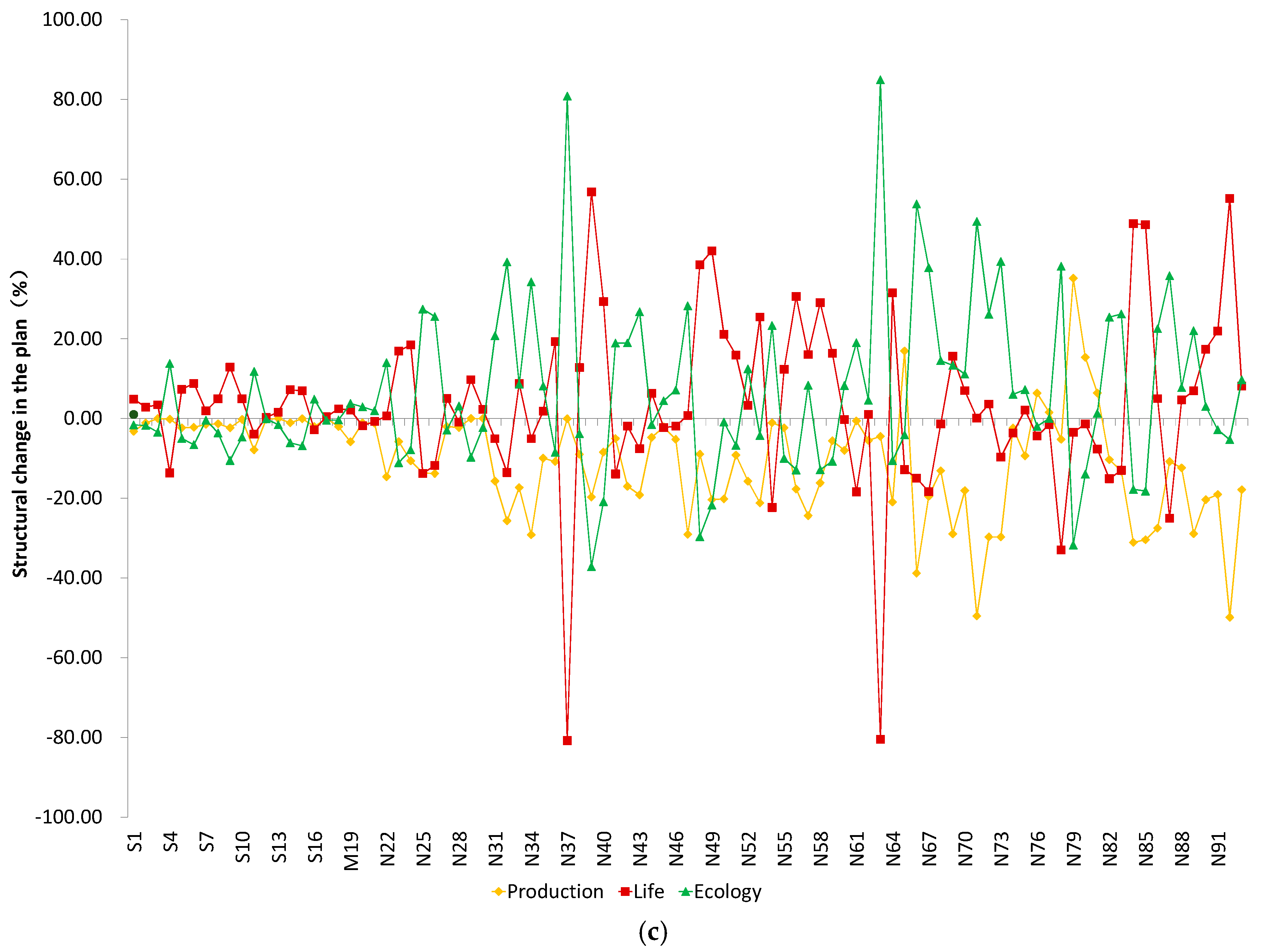

| Production Indicators | Ecological Indicators | Life Indicators |
|---|---|---|
| Profit per 10,000 output value | Area of vegetation restoration | Per capita living space of urban residents |
| Area per 10,000 output value | Ecological land scale | Per capita living space of rural residents |
| Energy consumption per 10,000 output value | Forest coverage | Average life expectancy |
| Expected benefit of low efficiency land redevelopment | Compliance level of water quality | National income per capita |
| GDP | Air quality standards | Proportion of communities from schools near 500 m |
| Per capita GDP | Sound quality standards | Improvement rate of city management system |
| Gross industrial output value | PM2.5 | Percentage of R&D investment for GDP |
| Gross agricultural output value | Soil quality standards | Proportion of scientific researchers per 10,000 persons |
| Total output value of tertiary industry | Improvement level of landscape function | Public satisfaction with planning |
| Ratio of output values among primary, secondary, and tertiary industries | Water resources per capita | Percentage of educational funds for GDP |
| Input-output rate of land use | Green area per capita | Road area per capita |
| Land economic density (net output value) | Treatment rate of land pollution | Housing price-to-income ratio |
| Land net income | Soil erosion degree | Green rate in built-up area |
| Investment effect coefficient of land use | Reuse rate of industrial wastewater | Unemployment rate |
| Payback period of land use | Investment in environmental population treatment per area | Coordination between architecture and environment |
| Proportion of low-yielding land | Percentage of environmental protection investment to GDP | Completeness of infrastructure |
| Land intensive use degree | Number of historical relics | Proportion of urbanized population |
| Land scale management degree | Water use per 10,000 output value | Ratio of per capita income in urban and rural areas |
| Class 1 Land | Class 2 Land | Class 3 Land | Refinement of Dominant Function | Functional Types |
|---|---|---|---|---|
| Agricultural land | Cultivated land | Cultivated land | Grain production | Production |
| Eco landscape | Ecology | |||
| sightseeing and experience of agriculture | Life | |||
| Garden plot | Garden plot | High-tech agricultural function | Production | |
| Eco landscape | Ecology | |||
| Forest land | Forest land | Eco landscape | Ecology | |
| Agricultural production | Production | |||
| Grassland | Grassland | Eco landscape | Ecology | |
| Other agricultural lands | Land for agricultural facilities | Agricultural production | Production | |
| Rural land | Residential supporting function | Life | ||
| Water level of pond | Agricultural production | Production | ||
| Water conservancy land and ridge of farmland | Agricultural production | Production | ||
| Land use for building | Rural–urban construction land | City | Residential, infrastructure, and other functions | Life |
| Parkland | Ecology | |||
| Organic town | Residential, infrastructure, and other functions | Life | ||
| Rural settlements | Residential function | Life | ||
| Other independent construction land | Industrial production | Production | ||
| Traffic and water conservancy land | Land use for railway, highway, and airport | Material flow connecting channel | Production | |
| Land use for pipeline transportation | Transportation | Production | ||
| Land use for water level of reservoir and hydraulic construction | Water supply or eco landscape | Ecology | ||
| Others | Land use for famous scenic site | Humanity and eco landscape | Ecology | |
| Special land use | Military, funeral, and other functions | Ecology | ||
| Others | Water land | Water land | Eco landscape | Ecology |
| Nature reserve | Nature reserve | Eco landscape | Ecology |
| Statistic | North (ha) | Middle (ha) | South (ha) | Total (ha) |
|---|---|---|---|---|
| Maximum | 1268.69 | 2069.24 | 3952.52 | 3952.52 |
| Minimum | 4.04 | 197.29 | 178.55 | 4.04 |
| Standard deviation | 274.77 | 905.64 | 817.98 | 515.69 |
| Average | 332.71 | 997.38 | 851.24 | 463.23 |
| Total | 23,622.70 | 4986.90 | 14,471.01 | 43,080.61 |
| Target Layer | Index Layer | Unit | Weight of Functional Area | ||
|---|---|---|---|---|---|
| N | M | S | |||
| Economic indicators () | Land occupation per 10,000 output value | hm2 (−) | (0.30, 0.21) | (0.20, 0.21) | (0.35, 0.21) |
| Land intensive utilization | % (−) | (0.30, 0.164) | (0.20, 0.164) | (0.35, 0.164) | |
| GDP | Hundred million yuan (+) | (0.30, 0.246) | (0.20, 0.246) | (0.35, 0.246) | |
| Total output value of the third industry | Hundred million yuan (+) | (0.30, 0.205) | (0.20, 0.205) | (0.35, 0.205) | |
| Output ratio of the third industry to the second industry | % (+) | (0.30, 0.175) | (0.20, 0.175) | (0.35, 0.175) | |
| Ecological indicators | Proportion of the ecological land scale | % (+) | (0.35, 0.21) | (0.50, 0.21) | (0.25, 0.21) |
| Number of historical relics | Pc (+) | (0.35, 0.154) | (0.50, 0.154) | (0.25, 0.154) | |
| Water resources per capita | m³ (+) | (0.35, 0.174) | (0.50, 0.174) | (0.25, 0.174) | |
| Green area per capita | m2 (+) | (0.35, 0.188) | (0.50, 0.188) | (0.25, 0.188) | |
| Ratio of environmental protection investment to GDP | % (+) | (0.35, 0.135) | (0.50, 0.135) | (0.25, 0.135) | |
| Improvement of landscape function | % (+) | (0.35, 0.139) | (0.50, 0.139) | (0.25, 0.139) | |
| Livable indicators | Ratio of green land in built-in area | % (+) | (0.35, 0.169) | (0.30, 0.169) | (0.40, 0.169) |
| Percentage of communities with schools within 500 m | % (+) | (0.35, 0.190) | (0.30, 0.190) | (0.40, 0.190) | |
| House price–income ratio | % (+) | (0.35, 0.177) | (0.30, 0.177) | (0.40, 0.177) | |
| Land use ratio of scientific research institutes | % (+) | (0.35, 0.168) | (0.30, 0.168) | (0.40, 0.168) | |
| Proportion of urbanized population | % (+) | (0.35, 0.173) | (0.30, 0.173) | (0.40, 0.173) | |
| Road area per capita | m2 (+) | (0.35, 0.123) | (0.30, 0.123) | (0.40, 0.123) | |
© 2017 by the authors. Licensee MDPI, Basel, Switzerland. This article is an open access article distributed under the terms and conditions of the Creative Commons Attribution (CC BY) license (http://creativecommons.org/licenses/by/4.0/).
Share and Cite
Yan, J.; Shen, Y.; Xia, F. Differentiated Optimization of Sustainable Land Use in Metropolitan Areas: A Demarcation of Functional Units for Land Consolidation. Sustainability 2017, 9, 1356. https://doi.org/10.3390/su9081356
Yan J, Shen Y, Xia F. Differentiated Optimization of Sustainable Land Use in Metropolitan Areas: A Demarcation of Functional Units for Land Consolidation. Sustainability. 2017; 9(8):1356. https://doi.org/10.3390/su9081356
Chicago/Turabian StyleYan, Jinming, Yue Shen, and Fangzhou Xia. 2017. "Differentiated Optimization of Sustainable Land Use in Metropolitan Areas: A Demarcation of Functional Units for Land Consolidation" Sustainability 9, no. 8: 1356. https://doi.org/10.3390/su9081356





